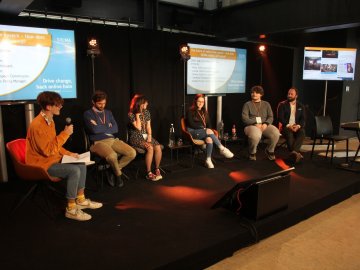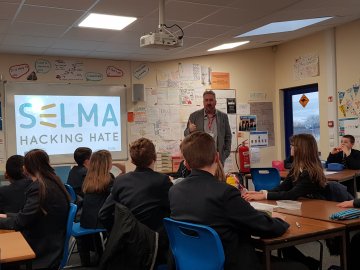Every month, we focus on a different dimension of the online hate speech phenomenon. These monthly focuses allow to foster a better understanding of how hate speech affects people, how we can respond to it and how we can effect positive change at a wider societal level.
In March, we delved into the reasons why people spread hate online; in April, we looked at the consequences of hate speech; and in May, we explored various initiatives promoting tolerance and empathy online. The month of June we will, in turn, focus on the topic of counter-narratives against hate speech: what they consist of, how they work, and how to enable young people to produce and promote them among their peers and their wider communities.
Countering hateful narratives and promoting mutual awareness
Young people not only need to be able to recognise hate speech in all its forms, they also need to understand what options are open to them in how to respond to this content. The use of counter-narratives is an example of reaction young people can take independently to reduce the prevalence of hate content. Moreover, society and civil society organisations also have a crucial role in the prevention of online hate speech by developing counter-actions, counter-speech and awareness campaigns.
A narrative is understood as a way of presenting or understanding a situation or series of events that reflects and promotes a particular point of view or set of values. Narratives influence the way we think and guide our decisions and actions. According to the Council of Europe, counter-narratives “combat hate speech by discrediting and deconstructing the narratives on which they are based. They also propose (alternative) narratives based on human rights and democratic values, such as openness, respect for difference, freedom and equality. They may do so by providing alternative and accurate information, by using humour and appealing to emotions on the issues involved, and by accounting for different perspectives and views”.
Sometimes it is difficult to confront widespread hateful messages. As explained in the guide “WE CAN! Taking Action against Hate Speech through Counter and Alternative Narratives” developed by the No Hate Speech movement, rational argumentation and hard data are often not enough to change the public discourse or hateful ideas. Stories are fundamental. Narratives provide interpretations of reality and have an important emotional dimension that makes data mean something to people.
The Against Violent Extremism network released a short video introducing counter-narratives, which you can watch below.
The network has also released videos on how to introduce creativity in counter-narrative campaigns and how to use social media platforms to counter hate messages.
SELMA in action
Throughout the month of June, we are exploring how to develop counter-narrative campaigns through the following actions:
- First, the SELMA partner from Denmark ‘Centre for Digital Youth Care’ will reflect on how to best develop counter-narrative strategies by introducing “Lige På”, a Danish podcast series aiming to prevent radicalisation, extremism and hate speech, produced for and by young men aged 15-25, and giving them a space to discuss and reflect on the various issues they face in their daily lives and how they deal with these emotionally.
- Then, we will look at what counter-narratives are and how to create and disseminate them on a wider scale through the eyes of four young people that won a national hackathon organised by the SELMA partner ‘For Adolescent Health (FAH)’ in Greece earlier this year.
- Finally, we will publish an article about a German project called ‘LOVE-Storm’, which has established an active community that reacts to online hate attacks protecting the victims, mobilising other users and deescalating situations. In this regard, , we will translate an infographic with ten tips to react quickly and effectively to online hate.
If you are looking for strategies and resources to prompt young people to counter hateful narratives online, do not miss the SELMA Toolkit, which offers a wide range of activities to raise awareness, promote counter-narratives, disrupt negative behaviours and amplify positive messages.
More precisely, in the ‘What's my role and what can I do?’ theme, the ‘Social and Emotional Learning’ activity ‘Assume a role’ helps young people understand how they can influence the outcome of a situation and who the main players are in a given group situation. In the same theme, the ‘Media Production’ activity ‘Making memes’ encourages them to create a humorous memes as a counter-narrative tool. The ‘Citizenship’ activity of the same theme brings the memes creation one step forward. It invites them to create a meme bank in their school to help other students to de-escalate hate situations.
The ‘Media Production’ activity of the ‘How can I influence my people?’ theme focuses on the creation of a counter-narrative campaign to hack online hate. The purpose of this activity is to introduce learners to the broad concept of counter-narrative plans by learning what a counter-narrative is, discovering some campaign examples and starting drafting their own campaign.
The counter-narratives focus will also unfold on social media. Therefore, be sure to keep an eye on our Twitter hashtag #SELMA_eu, while following us on Facebook.






